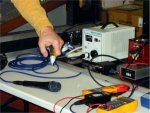Re: Bad mic shock
 .
.
Probably not something yous big fish have to deal with - but I carry a grounding clip on 8 feet of green wire that has a three prong plug on it (ground prong used only) for the occasional vintage amp that I encounter. It gets clipped on the shell on the instrument cable at the amp after I set the polarity correctly. Not perfect but if someone wants to run an all original 60's amp damned if I'm gonna deprive them of using it and me of hearing it - can't say I've run into anyone running one that wasn't a monster playerI'm wondering if he was using vintage guitar amp...

